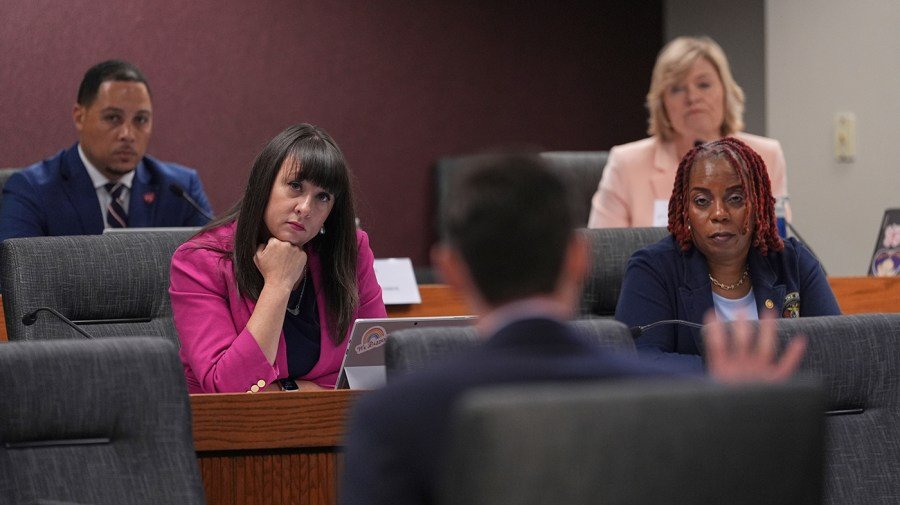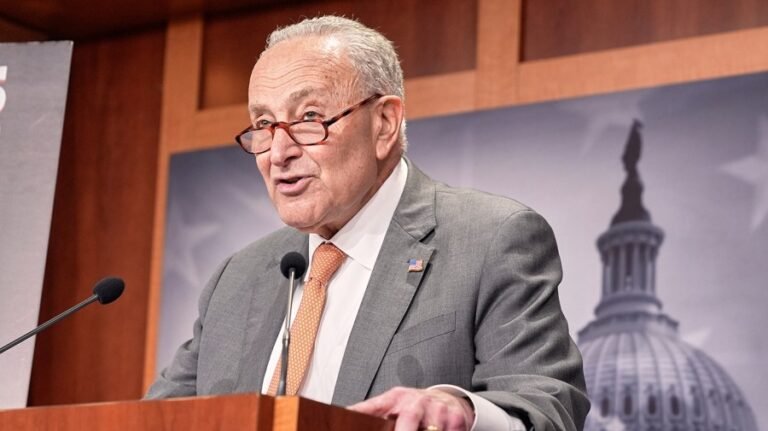
Democrats in Indiana, Ohio and Missouri face few good options to counter the GOP in its efforts to push forward with redistricting.
In Texas, Democrats temporarily blocked efforts to pass a GOP-friendly House map by leaving the state to deny Republicans the minimum number of lawmakers needed to conduct business. But Democrats in the three Midwestern states don’t have the numbers needed to deny Republicans a quorum, depriving them of one of the most effective ways to stall the redistricting process.
The situation has meant many Democratic leaders are struggling to find ways to fight back against potential new maps — and are leaning on each other for support.
“My job for the last several weeks has been to constantly explain to people why we’re going to lose this fight. That is a deeply demoralizing position to be in as a leader,” said Missouri House Minority Leader Ashley Aune (D).
“Just being able to know there are other folks out there going through the same thing, who are also having difficult conversations with their caucus members and their communities — sometimes it just helps to know that you’re not alone,” she said.
Having limited power in these states has been a reality for Democrats for years. The party hasn’t had a majority in any house of the three states’ legislatures for at least a decade, if not longer.
But the party’s minority status could cost it even further representation in the U.S. House and cement an even more dominant Republican edge.
The map that Missouri Gov. Mike Kehoe (R) has proposed would likely increase the margin in his House delegation from six Republicans and two Democrats to seven and one. It would do this by splitting the Kansas City-area district, which is currently represented by Rep. Emanuel Cleaver (D), into two districts and diluting the city’s political power with more conservative rural areas.
Ohio, which unlike other states was already required to redraw its maps this year, hasn’t yet moved forward with advancing new maps. But Republicans are expected to try to pick up at least two currently Democratic-held districts to improve their 10-5 margin in the House.
“Every indicator so far from the leadership in the Republican caucus has been that … they want to do what’s best for the state of Ohio first, and my hope is that that’s true and that that’s where we start,” said Ohio Senate Minority Leader Nickie Antonio (D).
While breaking quorum isn’t an option for his party, Ohio House Minority Leader Dani Isaacsohn (D) said Democrats can turn to the referendum process or ballot initiatives in response.
“People are losing their health care and their health insurance, and hospitals are closing and kids are going hungry because we don’t have fair maps in Ohio,” Isaacsohn said, referring to impacts from President Trump’s mega policy bill, which was passed in the GOP-dominated House and Senate.
Whether Indiana will attempt to redistrict still seems uncertain, with some state Republicans not expressing enthusiasm about the idea. But if they decide to try to take out one or both Democratic House members currently in office, Democratic state lawmakers don’t have many legislative tools to stop them.
Still, Indiana Democrats say they’ll use public pressure to make it difficult for Republicans should the GOP go through with mid-decade redistricting. They have also left the door open to procedural tactics to slow down the process. Democrats are three members short of being able to deny House Republicans quorum to temporarily halt possible legislation in the Hoosier State, though the party could also work together with Republicans who defect from their party over the redistricting issue.
“We don’t have the numbers for a walkout … like what happened in 2011, but I have made it clear with my Republican colleagues, if you are sincere in saying you don’t want this, let us help you. Let’s work together and do the right thing for Hoosiers,” said Indiana Senate Minority Leader Shelli Yoder (D).
Indiana state Rep. Matt Pierce (D) said Democrats could try a number of procedural measures available to them to slow the process down, but if Republicans stick together to have a quorum, redistricting efforts will move forward. He said the party has been working to try to make the public more aware of what Trump wants state lawmakers to do.
“We’ve been trying to get the public engaged and getting them to push back,” Pierce said. “And I think that a lot of people have been rallying at the state House and raising the alarm bells. But I think at the end of the day, it’s going to have to be Republicans who say no.”
Democrats in the Midwestern states have also been communicating with each other, using each other as sounding boards in thinking through the redistricting battles ahead, though each state legislature is governed by different rules. There have been talks of holding a press conference among the three states, though no initiatives have been finalized.
The redistricting battle, which started off as a push from President Trump and the White House to get Texas to redraw its maps, has morphed into a national fight as the White House looks to gain further seats in Missouri and Indiana.
Democrats in California are teeing up maps that would neutralize Texas’s expected gains, with voters expected to weigh in on them in November. Other blue states could follow suit.
Democratic leaders in some Midwestern states have also been in touch with national Democratic groups including the Democratic National Committee (DNC) and Democratic Congressional Campaign Committee (DCCC).
“Just like in Texas and California, the DNC is all hands on deck to help Missouri Dems fight back against Trump rigging Missouri’s Congressional maps and silencing the voices of Missourians,” DNC spokesperson Abhi Rahman said in a statement.
“Democrats are rising up to protect voters’ rights, and we’re not pulling our punches,” he added. “The DNC will stand with Missouri Democrats protecting the rights of all Missourians as Donald Trump and spineless Republicans try to rig the game.”
A DNC source familiar with the matter noted some of the efforts the national party has been involved with in Missouri include using their organizing team to recruit attendees in the state to participate in a rally next Wednesday and helping state Democrats hold town halls.
Meanwhile, another source familiar with the matter told The Hill the DCCC committed six figures toward polling and messaging efforts on redistricting in Missouri and Texas.
Republicans in blue states such as Illinois and Maryland are contending with a similar conundrum, as GOP members also don’t have the needed numbers to break quorum should those states ultimately move forward with redistricting. But Democrats don’t have many good options for adding seats in either state given they’re already both heavily favored toward their party.
In fact, a court struck down an 8-0 map crafted by Maryland Democrats in 2022 over partisan gerrymandering. Democrats in the Old Line State could risk seeing a repeat of that situation again if they try to weaken Rep. Andy Harris’s (R-Md.) district in the Eastern Shore.
“Politically, I think that the vast majority of Marylanders, including this ever-growing block of independents who hate both parties doing these blatant maneuvers, may have some negative feelings heading into 2026 about this, both for Gov. Moore and for legislative Democrats if they choose to push it through,” Maryland House Minority Leader Jason Buckel (R) told The Hill.
While there are risks for Democrats to overplay their hand in several blue states, members of the party warn there’s risk for their GOP counterparts in red states just the same.
Pierce added he believes Republicans are underestimating the potential backlash, as Indiana has one of the lowest voter turnout rates in the country, but that could change. He said this could improve Democrats’ margins in key races or even help in statewide elections.
“There is that possibility that it’s going to fire up the Democrats and make them angry enough that they’re going to work harder and more people will be motivated to come out and vote,” he said.


